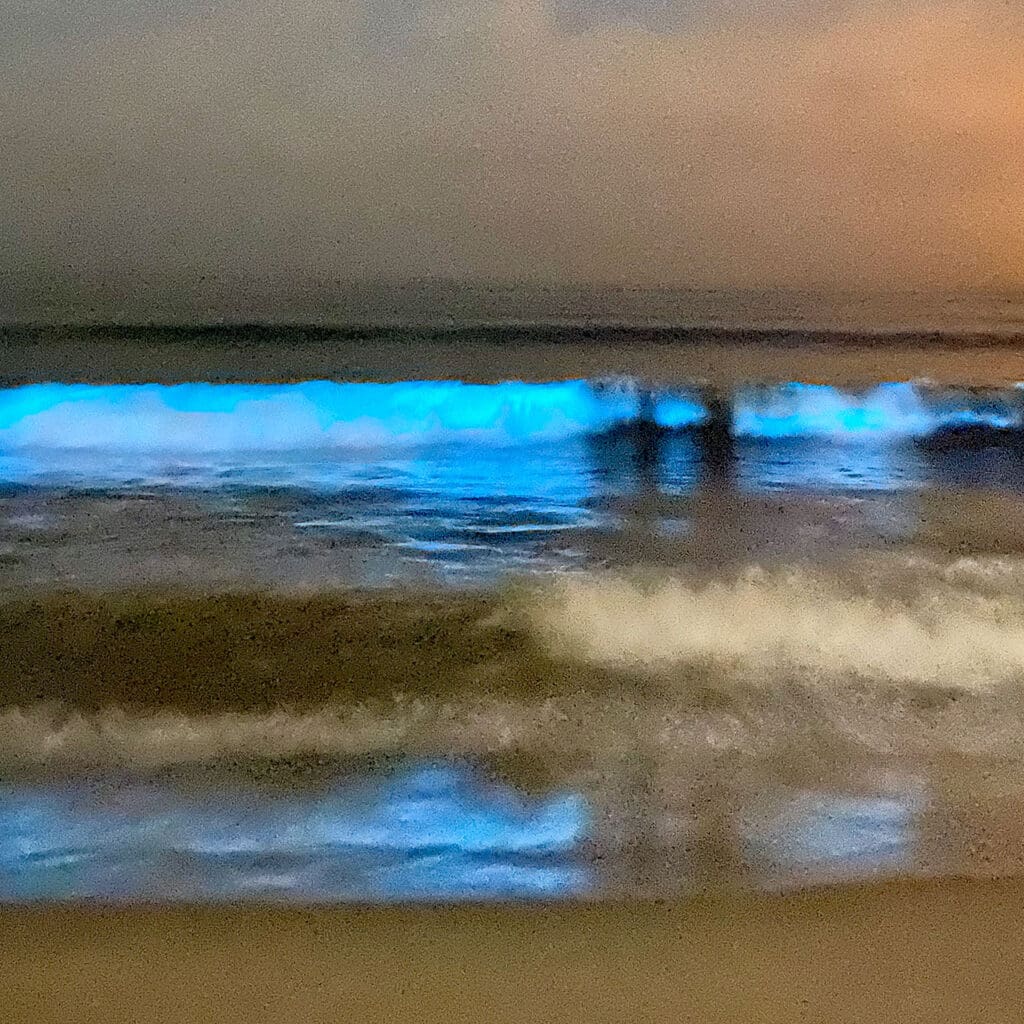As the sun sets and twilight falls, an extraordinary phenomenon begins to unfold beneath the waves. In the dim darkness of the ocean, nature’s own light show flickers to life—an enchanting glow of blues, greens, and purples that originates from some of the tiniest organisms off our coast.
The Science Behind the Glow
Bioluminescence is the production and emission of light by living organisms. This dazzling phenomenon occurs when specific chemicals within an organism interact—a process usually involving the compound luciferin, an enzyme called luciferase, and oxygen. Together, these ingredients create the glowing light that makes bioluminescence possible.
The glowing effect serves multiple purposes in nature:
- Defense Mechanism: Some organisms, like dinoflagellates, emit light to confuse or deter predators.
- Communication: Bioluminescent displays help organisms find mates or signal to others of their kind.
- Hunting Tool: Anglerfish famously use bioluminescence to lure prey into their waiting jaws.
What makes bioluminescence even more extraordinary is its efficiency; it generates light without producing heat, giving rise to the term “cold light.”
Who’s lighting up the ocean?
A wide range of creatures contribute to bioluminescence in the Atlantic Ocean. Off our coast you might encounter:
- Dinoflagellates: These microscopic organisms can produce sparkling displays when disturbed by movement, such as waves or diving fins.
- Comb Jellies: Known for their mesmerizing rainbow light patterns, comb jellies are truly the stars of the bioluminescent world.
- Firefly Squid: Though rare in South Florida, this squid species emits glowing signals to communicate and attract mates.
- Jellyfish: Some jellyfish species boast bioluminescent properties that create magical underwater illuminations.
- Glowing Fish: Certain fish, like lanternfish, use bioluminescence as a survival tool in the deep ocean.
Even bacteria can glow, transforming marine surfaces into glowing patches or creating “milky seas” under the right conditions.
Where and when to witness bioluminescence
Bioluminescence can be observed year-round, but it’s most noticeable during the warmer months, when higher concentrations of dinoflagellates gather near the shore. Fort Lauderdale’s coastal waters provide excellent opportunities to witness this phenomenon, particularly:
- Nighttime Diving: The best way to immerse yourself in the glowing world of bioluminescence is through night dives. The darkness reveals the hidden light show beneath the waves.
- Kayaking and Paddleboard Tours: Local operators offer bioluminescent tours along mangrove-lined waterways, giving you a surface-level view of the magic.
- Moonless Nights: Darkness amplifies the bioluminescent effect, so plan your excursions around new moons for optimal visibility.
Remember, patience is key; bioluminescent displays often require low light conditions and calm waters to be fully appreciated.
How to prepare for a bioluminescent dive
Experiencing bioluminescence underwater requires special preparation, but the effort is well worth it for the spectacle awaiting divers.
- Gear Up for Night Diving: Ensure you have reliable equipment, including dive lights, glow sticks, and proper exposure protection. If you are shore diving or diving with a Diver Down flat, be certain that your flag has a light on it as well. Personal torches can be switched off when the bioluminescence starts (to enhance the effect) but you should NEVER dive at night with an unlit flag.
- Stay Calm and Gentle: Disturbing the water gently creates glowing trails from dinoflagellates, whereas aggressive movements might scare away glowing creatures.
- Dive with Experts: Choose dive operators who know the best locations for witnessing bioluminescence and can guide you safely through night diving.
Marine conservation and bioluminescence
As mesmerizing as bioluminescence is, it’s a fragile gift from nature that requires thoughtful care and conservation. Pollution, climate change, and habitat destruction all threaten the delicate balance of ecosystems that support bioluminescent organisms.
Fort Lauderdale’s dive and conservation communities have taken steps to protect marine habitats, including:
- Coral Reef Restoration: Healthy reefs provide a home for glowing organisms like jellyfish and comb jellies.
- Responsible Diving Practices: Divers are encouraged to minimize disruption to underwater ecosystems while observing bioluminescence.
- Educational Programs: Public awareness campaigns teach residents and visitors about the importance of conserving bioluminescent habitats.
A glowing reminder of nature’s wonder
Bioluminescence offers a profound reminder of the beauty and ingenuity of the natural world. The ocean’s shimmering light displays inspire wonder and curiosity, connecting us to the mysteries of life beneath the waves. Whether you’re exploring bioluminescence on a dive or simply marveling at glowing shores, this phenomenon invites us to slow down, look closer, and cherish the magic surrounding us.

